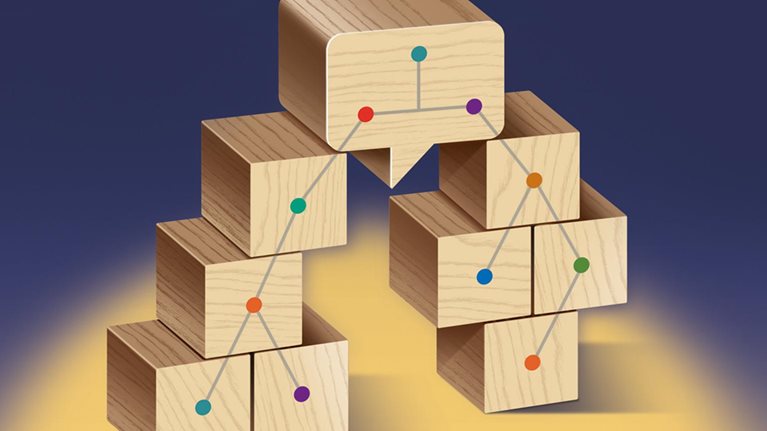Employee resistance is the most common reason executives cite for the failure of big organizational-change efforts.1 Winning over skeptical employees and convincing them of the need to change just isn’t possible through mass e-mails, PowerPoint presentations, or impassioned CEO mandates. Rather, companies need to develop strong change leaders employees know and respect—in other words, people with informal influence. But there’s one problem: finding them. How can company leaders identify those people beforehand to better harness their energy, creativity, and goodwill—and thereby increase the odds of success?
One way we’ve found is “snowball sampling,” a simple survey technique used originally by social scientists to study street gangs, drug users, and sex workers—hidden populations reluctant to participate in formal research. These brief surveys (two to three minutes) ask recipients to identify acquaintances who should also be asked to participate in the research. Thus, one name or group of names quickly snowballs into more, and trust is maintained, since referrals are made anonymously by acquaintances or peers rather than formal identification.2
In business settings, the methodology is easily adapted to better understand the patterns and networks of influence that operate below the radar.3 Indeed, informal influencers exist in every organization, across industries, cultures, and geographies. They are, simply put, people other employees look to for input, advice, or ideas about what’s really happening in a company. They therefore have an outsized influence on what employees believe about the future, as well as on morale, how hard people work, and their willingness to support—or resist—change.
Finding these employees is relatively easy using snowball sampling. Companies can construct simple, anonymous e-mail surveys to ask, for example: “Who do you go to for information when you have trouble at work?” or “Whose advice do you trust and respect?” In shop-floor and retail-store settings where workers don’t have ready access to e-mail, companies can use anonymous paper surveys. By asking employees to nominate three to five people (or more in very large organizations) who are also surveyed, executives can quickly identify a revealing set of influencers across a company. When the names of nominees start to be repeated—often, after only three to four rounds—the survey can end.
The results are often surprising. For example, in our work using the methodology in the aerospace, financial-services, health-care, manufacturing, retailing, and trucking industries (as well as in public-sector settings), we’ve found that influencer patterns almost never follow the organizational chart. Informal influencers exist at all levels of a company and aren’t easily identified or predicted by role or tenure (although relatively few are senior company leaders, as might be expected given their formal influence).
Moreover, we find that even when company leaders believe they know who the influencers will be, they are almost always wrong. At one large North American retailer, for instance, we compared a list of influencers that two store managers created before the survey with its actual results. Between them, the managers overlooked almost two-thirds of the influential employees their colleagues named; worse, both managers missed three of the top five influencers in their own stores. The retailer’s inability to recognize its influencers is no anomaly; we’ve observed a similar pattern in every other industry and geography we’ve studied.
Armed with a better sense of how influence operates, senior executives can begin applying that knowledge in useful ways. For example, they can encourage influencers to help communicate necessary changes, convince skeptical employees of the need for change, or, best of all, do these things as active architects of the program. Indeed, the most powerful way to use hidden influencers is to bring them into such efforts in the earliest stages and to get their input and guidance on planning and direction—as well as help with execution. Changes made with the support of these influential employees are vastly more likely to succeed in the long run than changes delivered from on high.
Consider the experiences of an aerospace company that used snowball sampling to jump-start an operational-change program across its factory network and of a large manufacturer that used this approach to support a major cultural-change initiative. A close look at their experiences suggests four principles useful for other organizations looking to tap into the power of hidden influencers.
1. Think broad, not deep. The manufacturer started with a pilot effort to identify about two dozen influencers and later expanded it to include an additional 75 or so. The company sought influencers in a swath of regions, functions, and roles (including frontline ones). The diversity of opinion and experience not only helped provide energy and good ideas but also later proved important in communicating the changes, in role-modeling them across the company, and in combating skepticism.
While there is no formula to determine how many influencers a company should include, the sample must be wide enough to pull in a diversity of roles and perspectives. For the aerospace company, this meant identifying 60 or so influencers working on different product lines and in different roles (including middle managers) on the shop floor. The goal is finding enough people with influence in enough roles to get a high degree of connectivity across the company through a relatively small number of connections (out of the total number possible). Some roles may prove to be particularly important: a retailer we studied, for example, found that its cashiers were generally well connected—most likely because they regularly interacted with colleagues in many departments. Cashiers who were influencers had considerable sway in the organization.
2. Trust, but verify. To build trust, participants at the manufacturer received letters of invitation explaining the program’s goals, why these employees had been nominated, and how the company wanted them to help. It took pains to make the initiative voluntary—an approach the aerospace company also used. Having influencers opt into change efforts builds trust and encourages high-quality results. Indeed, many influencers will be eager to help and view the experience as an honor worthy of their best efforts.
But goodwill dissipates quickly if employees feel coerced. Before extending any invitations, the manufacturing company discreetly vetted all participants with Human Resources and local managers. Vetting the participants helps “screen in” influencers who are well regarded by both peers and superiors,4 while acknowledging the reality that not all influence is positive and not all influencers want change. Although “bad eggs” should be screened out of important program roles, they still merit attention—as valuable sources of insight about how to convert skeptics.
3. Don’t dictate—cocreate. Both the aerospace company and the manufacturer engaged their influencers as thought partners in the change effort, not just as mouthpieces for change. That’s an important point because the influencers’ informal authority dwindles if they seem to be doing the bidding of management. The manufacturer, for example, flew the participants out to a central location, where they contributed to a multiday series of workshops. The aerospace company invited influencers from different product lines to meet regularly for a working lunch on the shop floor. In both cases, the participants were organized in teams addressing themes they helped identify (for example, shop-floor safety, incentives for employees to think more innovatively, and actions to make the company more customer focused). Because both efforts required sustained input from the participants, the meetings inspired and motivated them. As the programs gathered steam, many of these employees helped to spread feelings of empowerment in their usual roles as well.
4. Connect the dots. To boost the odds of lasting change, the manufacturer created an online forum, supported by videoconferences, aimed at encouraging the influencers to meet and support one another periodically. In an effort to make these interactions as meaningful as possible, the company divided the influencers into smaller, volunteer-led groups focused on common themes. This approach not only helps to produce more tangible actions and outcomes but also makes it easier for the groups to connect with colleagues working on similar projects in other regions or business units. The participants’ sense of community, and of themselves as change leaders, grows as they share best practices, discuss new ideas, and address the inevitable challenges. The company’s early commitment to in-person gatherings has made subsequent interactions by e-mail, telephone, or videoconference far more meaningful. In general, creating opportunities for influencers to meet in person usually pays big dividends.
Building on the themes identified by the manufacturer’s pilot group, the company’s full body of influencers is now implementing more than 50 culture-based initiatives. Some improvements are cross-cutting: for example, a new process to put employees’ creative ideas in front of managers for rapid review and, if warranted, deployment. Others are targeted at business-level improvements: for instance, a customer dashboard that’s meant to increase collaboration and has already dramatically improved sales. Thus far, several of the initiatives have led to promising increases in orders, market share, and margins. The aerospace company has implemented initiatives that helped to improve shop-floor safety, increase the number of on-time customer deliveries, and reduce plant inventory costs.
While the programs at both companies are works in progress, these early success stories have highlighted specific activities and behavior that drive performance. They are thus helping the companies to further articulate and accelerate the expected changes. Employee-satisfaction scores have also improved sharply at both companies, in large part thanks to increased levels of collaboration and empowerment.


